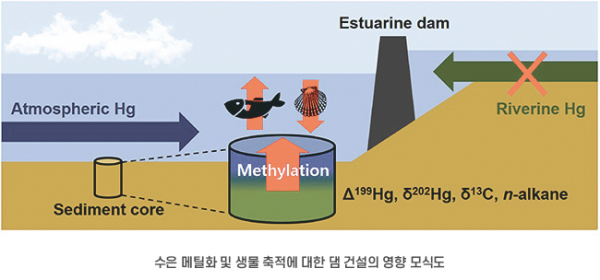
Over 30 years ago, dams built along Korea’s west coast promised prosperity and stability. Yet, over time, a hidden danger quietly began to emerge. Recently, a research team led by Professor Sae Yun Kwon (DESE) and Dr. Young-Gwang Kim from the Korea Research Institute of Standards and Science (KRISS) analyzed more than 30 years of data. Their findings revealed that infrastructure such as dams can significantly alter the pattern of bioaccumulation of toxic substances, including mercury. This research was published in the international environmental science journal Environmental Pollution.
The results were striking. Mercury levels in shellfish such as clams had decreased by 96%, but mercury in fish had increased by 106%. How could such contrasting results arise? The answer lay in the sediment. Analysis of estuarine sediment showed that while total mercury concentration decreased by 74%, the level of methylmercury, a form far more toxic and more easily bioaccumulated, increased by a staggering 536%.
The team traced the pathway of mercury using stable isotope analysis, which functions like a “fingerprint” for mercury. Before the construction of the dams, mercury from industrial complexes and inland sources flowed into estuaries mainly via rivers. After the dams were built, river flows were blocked, less mercury entered the estuaries, making atmospheric mercury deposition via rain and airborne dust the dominant contributor.
The critical issue is that mercury from the atmosphere is more readily converted into methylmercury. The ocean hosts a diverse array of microbes capable of converting inorganic mercury into methylmercury. As a result, methylmercury concentrations in estuarine sediments increased more than fivefold, and this toxic form of mercury entered fish through the food chain. This means that dams didn’t just alter water quality; they fundamentally changed the toxicity and bioavailability of mercury within the ecosystem.
This study demonstrates that simply measuring the total amount of pollutants is not enough to properly assess environmental impact. While the overall amount of mercury input appeared to decrease, the level of the more dangerous methylmercury had increased.

Prof. Kwon commented, “This study emphasizes the need to comprehensively evaluate the quantity of pollutants and how they affect organisms. Environmental impact assessments and water quality management policies should incorporate such subtle biogeochemical changes using a scientific approach.”
This research was supported by the Ministry of Science and ICT through the National Research Foundation of Korea’s General Researcher Support Program, and by the Ministry of Oceans and Fisheries through the Korea Institute of Marine Science and Technology Promotion’s Basic Research Program for Marine Bioresources.


